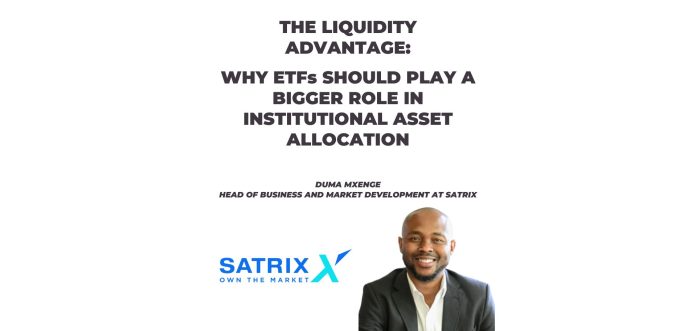Institutional investors are increasingly incorporating Exchange Traded Funds (ETFs) into their portfolios, attracted by their cost efficiency, transparency, and liquidity. As the investment landscape becomes more complex and cost-sensitive, ETFs are proving to be a powerful tool for modern portfolio management. Duma Mxenge explores their growing role in institutional investing, advantages over traditional investment vehicles, and their impact on market liquidity and institutional strategy.
The Rise of ETFs in Institutional Investing
ETFs are gaining traction among institutional investors for several reasons. They typically have lower management fees than active funds, which helps reduce total ownership costs. With daily disclosure of holdings, they offer transparency and clarity around asset allocation. ETFs trade throughout the day, enabling real-time portfolio adjustments, and provide built-in diversification by offering exposure across asset classes, sectors, and geographies.
Here are some of the other reasons they should be a strong contender for institutional asset allocation:
Risk Management in Volatile Markets
In periods of market uncertainty, ETFs offer both defensive capabilities and agility. Institutions can use them to maintain flexibility while hedging risk, shifting allocations quickly during downturns. They also enable tactical portfolio adjustments, allowing investors to act swiftly on market opportunities without disrupting broader strategies.

Complementing Active Management
Rather than replacing active strategies, ETFs complement them across multiple functions. They provide a cost-effective vehicle for implementing long-term strategic asset allocation (SAA), while also enabling rapid tactical reallocation (TAA) without requiring new manager engagements. ETFs are useful in managing transitions and liquidity, and can support dynamic risk management through alternative exposure strategies for rebalancing or hedging.
Enhancing Liquidity for Pension Funds
For pension funds and insurers, ETFs offer practical liquidity solutions. They can act as a “liquid sleeve” – a readily accessible reserve asset that can be quickly liquidated. Institutions can stay invested while retaining liquidity, avoiding large idle cash positions. Short-duration bond ETFs, in particular, offer an alternative to cash drag by providing better yield on low-risk holdings.
Tactical Allocation Without Strategic Disruption
ETFs are also powerful tactical allocation tools. They enable institutions to quickly overweight or underweight specific market segments in response to shifts, while still preserving the integrity of their long-term strategic asset allocation. This flexibility allows for nimble decision-making without derailing broader investment mandates and strategic asset allocation.
Cost Efficiency and Performance
While cost savings are a major driver, ETFs additionally deliver on performance and diversification. They closely track indices, enabling efficient beta capture and more reliable returns. By reducing single-stock exposure, they improve overall portfolio stability. Daily disclosures and intraday trading ensure greater transparency and execution efficiency.
Regulatory Support and Market Maturity
South African regulatory changes are accelerating ETF adoption. The higher offshore investment limit of 45% has promoted ETF use for global diversification. The new two-pot retirement system aligns well with ETFs’ liquidity and transparency. As institutional ETF usage grows, so too does market liquidity and efficiency, supporting the broader financial system.
Looking Ahead: Institutional Growth and Innovation
ETF adoption is expected to rise over the next decade, mirroring trends in the US and Europe. Cost pressures and the demand for transparency will continue to drive growth. Innovations in product offerings – especially systematic strategies such as factor-based and thematic ETFs – are well suited to ETF structures, thanks to their transparent, rules-based approaches.
As this unfolds, active strategies will continue to play a role but are likely to evolve. Managers will increasingly focus on high-conviction, niche strategies to deliver unique insights. The growth of actively managed ETFs offers a blended model that combines active thinking with the benefits of ETF structures. Hybrid portfolios that combine passive and active strategies may become the norm as institutions seek to optimise performance and manage risk.
ETFs are becoming essential components of institutional portfolios. As regulatory frameworks and investor demands evolve, ETFs are well-positioned to play an even more prominent role in shaping institutional investment strategies.
This article was originally published here.
Disclaimer
Satrix Investments (Pty) Ltd is an approved FSP in terms of the Financial Advisory and Intermediary Services Act (FAIS). The information does not constitute advice as contemplated in FAIS. Use or rely on this information at your own risk. Consult your Financial Adviser before making an investment decision.
Satrix Managers (RF) (Pty) Ltd (Satrix) is a registered and approved Manager in Collective Investment Schemes in Securities and an authorised financial services provider in terms of the FAIS.
While every effort has been made to ensure the reasonableness and accuracy of the information contained in this document (“the information”), the FSPs, their shareholders, subsidiaries, clients, agents, officers and employees do not make any representations or warranties regarding the accuracy or suitability of the information and shall not be held responsible and disclaim all liability for any loss, liability and damage whatsoever suffered as a result of or which may be attributable, directly or indirectly, to any use of or reliance upon the information.



